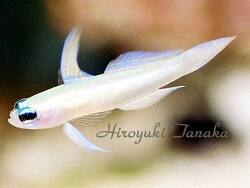Info
Tryssogobius colini, Larson & Hoese, 2001
They live on sand and gravel and, like the gobies of the genus Nemaleotris, immediately shoot into their hiding place in case of danger.
Aquarium care
Gobies are very shy and should initially be acclimatized in an aquarium that is not too brightly lit and has plenty of caves. If this is the case, the gobies will come out of hiding very quickly and return to the current. It is important that they have a short way to the cave or under
stones or corals.
Keeping and care is the same as for Trimma and Eviota. Socialization with both species and pipefishes should be possible. They initially eat Artemia nauplii and other live food, e.g. Tigriopus californicus and crushed frozen food. As planktivores they are constantly snapping at food, but can also cope with larger chunks. It is recommended to feed them at least 3 times a day.
Tryssogobius fairy gobies are very rare in the trade.
Jumping guard
A jumping guard prevents (nocturnal) fish from jumping out.
Wrasses, blennies, hawkfishs and gobies jump out of an unprotected tank in fright if their night rest is disturbed, unfortunately these jumpers are found dried up in the morning on carpets, glass edges or later behind the tank.
https://www.korallenriff.de/en/article/1925_5_Jump_Protection_Solutions_for_Fish_in_the_Aquarium__5_Net_Covers.html
A small night light also helps, as it provides the fish with a means of orientation in the dark!
They live on sand and gravel and, like the gobies of the genus Nemaleotris, immediately shoot into their hiding place in case of danger.
Aquarium care
Gobies are very shy and should initially be acclimatized in an aquarium that is not too brightly lit and has plenty of caves. If this is the case, the gobies will come out of hiding very quickly and return to the current. It is important that they have a short way to the cave or under
stones or corals.
Keeping and care is the same as for Trimma and Eviota. Socialization with both species and pipefishes should be possible. They initially eat Artemia nauplii and other live food, e.g. Tigriopus californicus and crushed frozen food. As planktivores they are constantly snapping at food, but can also cope with larger chunks. It is recommended to feed them at least 3 times a day.
Tryssogobius fairy gobies are very rare in the trade.
Jumping guard
A jumping guard prevents (nocturnal) fish from jumping out.
Wrasses, blennies, hawkfishs and gobies jump out of an unprotected tank in fright if their night rest is disturbed, unfortunately these jumpers are found dried up in the morning on carpets, glass edges or later behind the tank.
https://www.korallenriff.de/en/article/1925_5_Jump_Protection_Solutions_for_Fish_in_the_Aquarium__5_Net_Covers.html
A small night light also helps, as it provides the fish with a means of orientation in the dark!







 Dr. Gerald (Gerry) Robert Allen, Australien
Dr. Gerald (Gerry) Robert Allen, Australien











